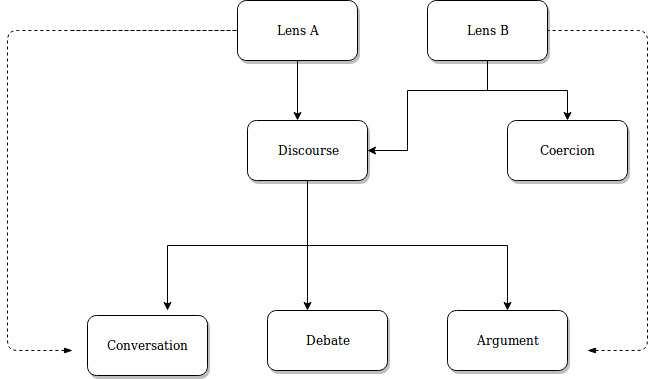Metaphors: Conflict and Agreement Patterns
People who hold differing views, opinions, and facts often engage in some form of interaction – but this interaction can be framed in different ways. Perhaps one person thinks: “I’m fairly sure that my information is correct, but lets figure out the truth together” - that person might engage in a discussion with the lens “together we can converge upon the truth” (lens B). However, the way that the majority of differences begins is with the thought “I am certain of one thing – the other person is wrong” which leads to the lens “I need to convince them of my viewpoint” (lens A).
Lens A: To convince someone; to change their mind
Lens B: To converge upon the truth; to reach mutual agreement
There then comes a fundamental tactical choice for lens A:
Discourse or Coercion
Obviously, this choice is not relevant for lens B, since you cannot reach mutual agreement through force (which coercion denotes). What’s particularly interesting is where the discourse option leads us. There are three options within discourse: conversation, debate and argument.
-
Conversation: A methodology that is isomorphic with lens A. Through peaceful and non-negative discourse there is an attempt to understand and work through the available viewpoints. There is an egalitarian ethos where there is no winner or loser, expert or amateur, there is only the open contemplation of ideas aimed at the furthering of mutual knowledge. There is an open presentation of ideas, and an attempt to overcome one’s preferences and biases.
Goal: The mutual search for truth and the progress of ideas. -
Debate: A methodology that is a balance between the two lenses. It is now a zero-sum game: there is “right” and “wrong”, a “winner” and a “loser”. There is no longer cooperation but opposition. There are now negative feelings such as dominance, superiority, and rejection. In debate, there is still a certain level of dis-identification from one’s ideas. The discourse relies on persuasion and rhetoric rather than “objectively” looking at the ideas. Debate quickly degenerates into argument due to competition for the status of “winner of the debate”. Agreement is much more rare.
Goal: To triumph over one’s opponent and prove one’s own ideas correct. -
Argument: A methodology that is isomorphic with lens B. There is now complete identification with one’s ideas or viewpoints. A rejection of one’s ideas is synonymous with a complete rejection of one’s being or self. One therefore defends (and therefore attacks) their ideas with all the vehemence and obstinacy of self-preservation. It is now one’s will, rather than persuasion, that characterizes the discourse. Any notion of pursuing truth is completely out of the picture. Argument is about negative emotions, attack and defense, and the ideas have become subordinate to the task of self-preservation. There is almost never agreement.
Goal: To beat the other person and making them feel that they are wrong; to protect oneself in order to not be completely destroyed.

It is clear that the most peaceful form of engagement is conversation, where there is an attempt to get at the truth - what is important is the ideas they are presenting. What this requires is trust; the ideas are standing out there open and exposed with no emotional reinforcement or attachment to one’s sense of self. It is almost a paradox, the best way to change someone’s mind is when you are simply trying to get to the truth of the matter. Perhaps your ideas end up being incorrect and that would be okay – it’s not about being right.
Interactions should be conversations, not arguments.